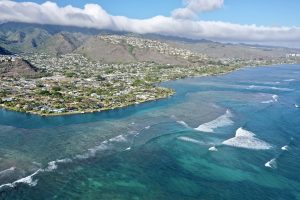The online system can give marine managers across the Pacific better data to act on as climate change intensifies the problem. Coral researchers in Hawaii recently developed a new early warning system that forecasts how likely it is for two common diseases to afflict those vital marine animals in the Pacific, and it already shows a strong chance of outbreaks across the Hawaiian archipelago this summer. The online tool, dubbed the “multi-factor coral disease risk,” forecasts a high risk of what are called growth anomalies to hit coral colonies on the windward side of Hawaii island, as well as across Maui and parts of Oahu and Niihau through August.
That risk of growth anomalies drops significantly along the Big Island by September, according to the tool. However, during that same month it forecasts a higher risk of the other common disease, called white syndrome, in various parts of the islands. The warning system also forecasts coral disease in the Northwestern Hawaiian Islands, as well as Australia’s Great Barrier Reef, Guam, the Northern Mariana Islands, American Samoa and a vast ocean area known as the Pacific Remote Islands.

The goal, researchers say, is to give regional groups and government agencies a tool to make better management decisions for the marine areas they cover as climate change causes coral disease outbreaks to occur more often. “Diseases are a natural part of ecological seasons, but we are seeing coral diseases occurring at a greater frequency and .























